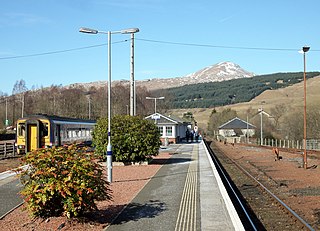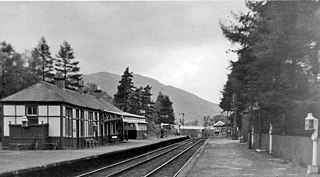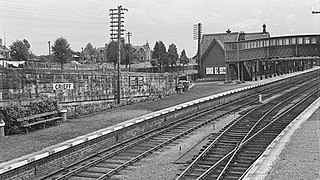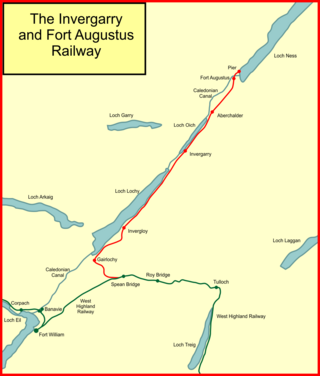
The Caledonian Railway (CR) was a major Scottish railway company. It was formed in the early 19th century with the objective of forming a link between English railways and Glasgow. It progressively extended its network and reached Edinburgh and Aberdeen, with a dense network of branch lines in the area surrounding Glasgow. It was absorbed into the London, Midland and Scottish Railway in 1923. Many of its principal routes are still used, and the original main line between Carlisle and Glasgow is in use as part of the West Coast Main Line railway.

The West Highland Line is a railway line linking the ports of Mallaig and Oban in the Scottish Highlands to Glasgow in Central Scotland. The line was voted the top rail journey in the world by readers of independent travel magazine Wanderlust in 2009, ahead of the notable Trans-Siberian line in Russia and the Cuzco to Machu Picchu line in Peru. The ScotRail website has since reported that the line has been voted the most scenic railway line in the world for the second year running.
The Callander and Oban Railway company was established with the intention of linking the sea port of Oban to the railway network. This involved a long line from Callander through wild and thinly populated terrain, and shortage of money meant that the line was opened in stages from 1866 to 1880.

Comrie is a village and parish in the southern Highlands of Scotland, towards the western end of the Strathearn district of Perth and Kinross, 7 mi (11 km) west of Crieff. Comrie is a historic conservation village in a national scenic area along the river Earn. Its position on the Highland Boundary Fault explains why it has more earth tremors than anywhere else in Britain. The parish is twinned with Carleton Place, Ontario, Canada.

Oban railway station is a railway station serving Oban in Scotland. It is the terminus of one branch of the highly scenic West Highland Line, sited 71 miles 44 chains (115.1 km) from Callander, via Glen Ogle. It was originally the terminus of the Callander and Oban Railway. All services are operated by ScotRail, who also manage the station.

Crianlarich railway station is a railway station serving the village of Crianlarich in Scotland. It is located on the West Highland Line, sited 41 miles 25 chains (66.5 km) from Craigendoran Junction, near Helensburgh, with Ardlui to the south, and Tyndrum Lower and Upper Tyndrum to the north west, on the routes to Oban and Mallaig respectively, which diverge immediately north of the station. ScotRail, who manage the station, operate most services.

The West Highland Railway was a railway company that constructed a railway line from Craigendoran to Fort William and Mallaig. The line was built through remote and difficult terrain in two stages: the section from Craigendoran to Fort William opened in 1894, with a short extension to Banavie on the Caledonian Canal opening in 1895.

Lochearnhead is a village in Perthshire on the A84 Stirling to Crianlarich road at the foot of Glen Ogle, 14 miles north of the Highland Boundary Fault. It is situated at the western end of Loch Earn where the A85 road from Crieff meets the A84.

Balquhidder was a railway station around two miles south of Lochearnhead, Stirling (district). It was where the Callander and Oban Railway was joined by the Comrie, St Fillans & Lochearnhead Railway from Crieff.
The Crieff Junction Railway was opened in 1856 to link the town of Crieff to the main line railway network in Scotland, at a junction at the present day Gleneagles station. In the second half of the twentieth century railway business declined sharply, and despite economy measures the line closed in 1964.
The Crieff and Methven Junction Railway was a Scottish railway, opened in 1866, connecting Crieff with a branch line that ran from Methven to Perth.

Crieff was a junction railway station at Crieff, Perth and Kinross, Scotland. It was where the Crieff Junction Railway, Crieff & Methven Railway and the Comrie, St Fillans & Lochearnhead Railway met.
The Killin Railway was a locally promoted railway line built to connect the town of Killin to the Callander and Oban Railway main line nearby. It opened in 1886, and carried tourist traffic for steamers on Loch Tay as well as local business. The directors and the majority of the shareholders were local people, and the little company retained its independence until 1923.
The Dunblane, Doune and Callander Railway was opened in 1858 to connect Callander and Doune with the Scottish railway network. When promoters wished to make a connection to Oban, Callander was an obvious place to start, and from 1880 Callander was on the main line to Oban. The railway network was reduced in the 1960s and the line closed in 1965. Oban is now served by a different route.
The Scottish Central Railway was formed in 1845 to link Perth and Stirling to Central Scotland, by building a railway line to join the Edinburgh and Glasgow Railway near Castlecary.

The Invergarry and Fort Augustus Railway was a branch-line railway built in Scotland, connecting the named places with the main line at Spean Bridge. It opened in 1903.
The Crieff and Comrie Railway was a Scottish railway, opened in 1893, connecting Comrie to the railway network at Crieff. The tourism potential of Loch Earn was an important factor, and the route was later extended westward to Lochearnhead. However the line was never successful, and declined in the twentieth century, particularly due to cheap and frequent bus competition. Four-wheel railbuses were introduced in 1958 to reduce operating costs, but the decline continued and the line closed on 6 July 1964.
Dalchonzie Halt railway station, Dalchonzie Platform railway station or Dalchonzie Siding in the Parish of Comrie, Perth and Kinross, Scotland was an intermediate stop on what became the Caledonian Railway's Crieff - Lochearnhead - Balquhidder branch line. It served the rural Strathearn area near Dunira, Dalchonzie House and Drumlochlan Wood from 1903 to 1951.

Lochearnhead is a former railway station in the village of Lochearnhead in Perthshire. It opened in 1904 as part of the Comrie, St Fillans & Lochearnhead Railway, but closed in 1951. Since 1962, the station has been used as a Scout centre for youth adventurous activities.

St Fillans railway station served the village of St Fillans, in the historical county of Perthshire, Scotland, from 1901 to 1951 on the Lochearnhead, St Fillans and Comrie Railway.












